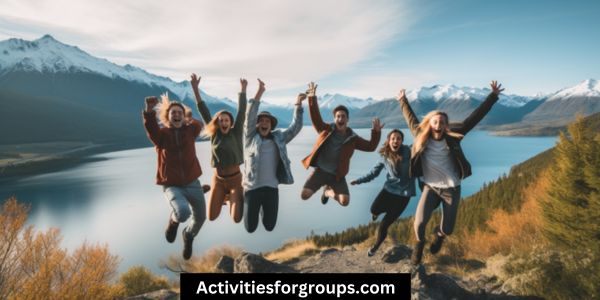Organizing outdoor adventures can be a lot of fun, but can also be complicated. Managing group dynamics is key to ensure everyone has a great experience.
You can do this by assigning roles, discussing expectations, setting ground rules, establishing communication, and monitoring progress.

With the right strategies in place, you’ll be well on your way to a successful outdoor adventure!
Assign Roles
You’ll need to assign roles to ensure everyone’s success on your outdoor adventure. It’s important to consider the team dynamics when assigning roles in order to maximize the effectiveness of the group.
Assigning tasks to individuals should be done based on their skillsets, strengths, and interests. This will ensure that each member is making a meaningful contribution and feeling valued. It’s also important to consider the level of risk associated with each task, to ensure that everyone is safe and that everyone is able to handle the assigned task.
When assigning roles, make sure to communicate effectively and clearly. Ensure that everyone understands the assigned task and the expectations associated with it. Each individual should feel empowered to take on responsibility for their tasks, and should be comfortable speaking up if something is unclear or if they need help.
Make sure to provide adequate support for each team member, especially those who may need more guidance. It’s important that all team members have a chance to contribute and feel valued for their contributions.
Discuss Expectations
Once roles have been assigned, it’s essential to discuss expectations with the group members to ensure that everyone is on the same page. Doing so helps to build trust and foster unity within the group.
When discussing expectations, it’s important to consider the following three points:
- Clarify the goals of the adventure. Is the goal to summit a mountain? Reach a certain milestone? Have fun and explore?
- Identify individual strengths and weaknesses. What skills do group members bring to the table? What particular areas need support?
- Establish ground rules. How will the group handle disagreements? Are there any safety protocols that must be followed?
Having honest conversations about expectations will bring the group closer together and help create a common understanding. This won’t only make the adventure smoother, but it will also help to create lasting memories. By discussing expectations, the group will be better equipped to handle any surprises that come their way.
Set Ground Rules

After clarifying the goals and identifying individual strengths and weaknesses, it’s time to set ground rules to ensure everyone is on the same page. Ground rules should be established to keep everyone safe, take into account the group dynamics, and promote team building.
This can be done by discussing the importance of listening skills, trusting each other, and respecting individual differences. Encourage everyone to communicate their thoughts and opinions openly, but ensure they’re being heard and respected.
In addition to discussing ground rules, it might be beneficial to incorporate trust exercises into the planning process. These activities can help build relationships and create a sense of camaraderie among the group. Examples of trust exercises include: passing a ball, forming a human chain, or having each person share a personal story.
Finally, remember that setting ground rules isn’t a one-time event. It’s important to review and adjust the rules as needed throughout the planning process. This will help ensure everyone is comfortable and that the group dynamics remain positive and cooperative.
Establish Communication
Second only to setting ground rules, establishing effective communication is key to successful group dynamics when planning outdoor adventures. Clear communication helps ensure everyone is on the same page and can avoid potential conflicts. This includes:
- Sharing goals and expectations with the group
- Staying in contact with the group, both before and during the adventure
- Developing strategies for conflict resolution
When sharing goals, be sure to be clear and concise about what each person should expect from the adventure. This could include the type of activities planned, any rules or regulations that must be followed, and levels of difficulty. This will allow each person to make an informed decision on whether the adventure is right for them.
In addition to sharing goals, it’s important to stay in contact with the group both before and during the adventure. This includes providing updates on the plan, organizing gear and transportation, and answering any questions that people may have. A great way to stay in touch is to create a group chat or email list, so that everyone can easily access information and ask questions.
Lastly, developing strategies for conflict resolution is key for managing group dynamics. This could include having a designated leader, or having a discussion about how to handle disagreements in a respectful and productive manner. Having a plan of action in place will help ensure that any issues that arise can be addressed quickly and effectively.
Monitor Progress

Throughout the adventure, it’s important to monitor progress and check in with each member of the group. Regularly checking in provides a way to ensure everyone is on the same page and foster collaboration. It’s also a way to provide feedback to the group and make sure everyone is staying on task and engaged.
When checking in, ask the group questions such as how they’re feeling, what challenges they’re facing, and how they’re doing in terms of completing tasks. It’s also important to take time to discuss any issues or disagreements that may have arisen. This allows the group to work together to resolve any issues and move forward.
In addition, be sure to take note of any changes in the group dynamics. If any changes are spotted, use this opportunity to talk to the group and find out what needs to be done to improve the situation. It’s also essential to recognize any successes the group has achieved and praise the members for their hard work.
Finally, make sure to keep track of any progress made. This will help to identify areas where the group can improve, as well as areas of success. It’s also a great way to motivate the group and help them stay on track.
Monitoring progress and checking in regularly can help make sure everyone is on the same page and foster collaboration. It’s an essential part of managing group dynamics and ensuring a successful outdoor adventure.
Frequently Asked Questions [FAQs]
What Is the Best Way to Ensure Everyone Has a Positive Experience?
To ensure a positive experience, stay organized and communicate clearly. Make sure everyone knows what to expect and is prepared for the adventure.
What Should I Do if Someone Is Not Following the Rules?
If someone is not following the rules, talk to them privately and build trust through problem solving. Be understanding and come up with solutions together.
How Can I Ensure Everyone Is Staying Safe?
Explain the risks, communicate expectations, and do a risk assessment. Ensure everyone is aware of potential dangers and agree on protocols to stay safe.
What Activities Are Best for Team-Building?
You could try ice-breaking activities like scavenger hunts or trust-building exercises. Risk assessment is key for any outdoor team-building activity.
How Do I Handle Disagreements Among Group Members?
Communicate expectations and set boundaries early on. If disagreements arise, listen carefully to each side and work towards a compromise everyone can agree on.
Conclusion
Organizing an outdoor adventure can be a rewarding experience! By taking the time to assign roles, discuss expectations, set ground rules, and establish communication, you can ensure that everyone involved is on the same page and that the group dynamics are managed in a positive way.
With the right preparation, your adventure will be a success!




Leave a Reply